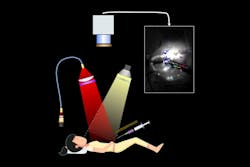Ovarian cancer is usually diagnosed only after it reaches an advanced stage, with many tumors spread throughout the abdomen. Most patients undergo surgery to remove as many of these tumors as possible (a procedure known as debulking), but because some are so small and widespread, it is difficult to get rid of all of them.
Researchers at MIT, working with surgeons and oncologists at Massachusetts General Hospital (MGH), have now developed a way to improve the accuracy of this surgery. Using a novel fluorescence imaging method, they could find and remove tumors as small as 0.3 millimeters—smaller than a poppy seed—during surgery in mice. Mice that underwent this type of image-guided surgery survived 40% longer than those who had tumors removed without the guided device.
“What’s nice about this system is that it allows for real-time information about the size, depth, and distribution of tumors,” says Angela Belcher, a biology professor at MIT.
The researchers are now seeking FDA approval for a phase 1 clinical trial to test the imaging device in humans. In the future, they hope to adapt the device for monitoring patients at risk for tumor recurrence, and eventually for early diagnosis of ovarian cancer, which is easier to treat if it is caught earlier.
Researchers at MIT have developed an image-guided surgical method that could help surgeons better find and remove tiny ovarian tumors. Fluorescent carbon nanotubes are used as probes that bind to the tumors, making them easier to see.
Because there is no good way to detect early-stage ovarian cancer, it is one of the most difficult types of cancer to treat. Of 250,000 new cases diagnosed each year worldwide, 75% are in an advanced stage. In the U.S., the five-year combined survival rate for all stages of ovarian cancer is 47%—only a slight improvement from 38% three decades ago, despite the advent of chemotherapeutic drugs such as cisplatin, approved by the FDA in 1978 for ovarian cancer treatment. In contrast, the five-year combined survival rate for all stages of breast cancer has steadily improved, from around 75% in the 1970s to greater than 90% now.
The new imaging device uses light in the near-infrared (NIR) spectrum to get an unprecedented combination of resolution and penetration-depth in living tissue. It helps surgeons find and remove small tumors during surgery by providing continuous, real-time imaging of the abdomen, with tumors highlighted by fluorescence. To make the tumors visible, the researchers designed chemical probes using single-walled carbon nanotubes that emit fluorescent light when illuminated by a laser. They coated the nanotubes with a peptide that binds to SPARC, a protein overexpressed by highly invasive ovarian cancer cells. This probe binds to the tumors and makes them fluoresce at NIR wavelengths.
The researchers tested the image-guided method in mice that had ovarian tumors implanted in a region of the abdominal cavity and showed that surgeons could locate and remove tumors as small as 0.3 millimeters. Ten days after surgery, these mice had no detectable tumors, while mice that had undergone the traditional, non-image-guided surgery had many residual tumors missed by the surgeon.
By three weeks after the surgery, many of the tumors had grown back in the mice that underwent image-guided surgery, but those mice still had a median survival rate that was 40% longer than that of mice that underwent traditional surgery.
No other imaging method could locate tumors that small during surgery, according to the researchers.
“You can’t have a patient in a CT or MRI machine and have the surgeon perform thee debulking procedure at the same time, but you can’t expose the patient to X-ray radiation for the several the surgery takes. This optics-based imaging method lets us to do the procedure safely,” Belcher says.
For most ovarian cancer patients, tumor debulking surgery is followed by chemotherapy, so the researchers now plan to do another study where they treat the mice with chemotherapy after image-guided surgery, in hopes of preventing the remaining tiny tumors from spreading.
“We know that the amount of tumor removed at the time of surgery for patients with advanced-stage ovarian cancer is directly correlated with their outcome,” Belcher says. “This imaging methods lets the surgeon go beyond the limits of resecting tumors visible to the naked eye and should usher in a new age of effective debulking surgery.”
Now that they have demonstrated that this concept can be successfully applied to imaging during surgery, researchers hope to begin adapting the method for use in human patients.
“In principle, it’s quite doable,” Belcher says. “It’s purely the mechanics and the funding at this point because the mouse experiment served as the proof of principle and may actually have been more challenging than building a human-scale method.”
The researchers also hope to use this type of imaging to monitor patients after surgery, and eventually to develop it as a diagnostic tool for screening women at high risk for developing ovarian cancer.
“A major focus for us right now is developing the technology to be able diagnose ovarian cancer early, in stage 1 or stage 2, before the disease becomes disseminated,” Belcher says. “That could have a huge impact on survival rates, because survival is related to the stage of detection.”


